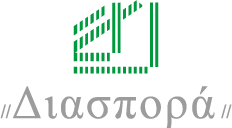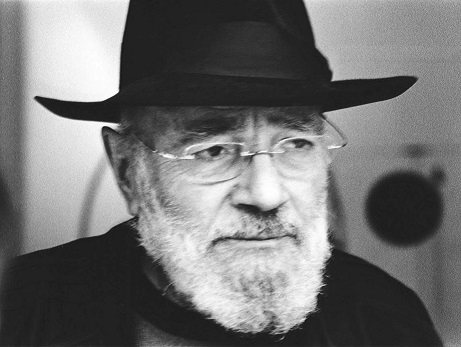Biography
Panagiotis Vasilakis, who was known as Takis, was born in Athens in 1925 to parents who were refugees from Smyrna. His adolescence was stigmatized by the tragedies, hardships and effects of the Occupation, and also of those immediately after the Civil War. Without any formal artistic training, he began his career in the mid-1940s. In his first steps, he draws inspiration from Greek archaic and Cycladic art, ancient plays of tragedy, as well as the work of Alberto Giacometti and Pablo Picasso, something that is evident in his early creations, his anthropomorphic silhouettes of wire, plaster and fabric. In 1952, he settled in the same workshop as Minos Argyrakis and the sculptor Panos Raimondos in Anakasa. Two years later, he moved to Paris where, while working on blacksmiths, he will be given the opportunity to discover his personal interest in cosmological issues and his inherent need for constant experimentation through mixing traditional techniques with science and technology. In 1955, he held his first solo exhibition, entitled Figures in Plaster, at the Hanover Gallery in London. On his return to France, the technological decoration of the railway station that surrounds him draws his attention and it is the cause of the decisive shift in his choice of expressive means. As a result he produces a series of works Signals, consisting of thin metal rods that, at the edges, carry heterogeneous objects like lamps, radio antennas or eyes, and refer to supernatural technological beings. Taki’s Signals will then take various forms and will be enhanced with other technological tools and objets trouvés, while, in 1957, he will make a series of “happenings” by combining them with fireworks on the streets of Paris. In 1958, he introduced magnetism as an essential part of his sculpture, and he creates his first telemagnetic sculptures from needles and threads which are pulsing through the magnet action. Since then, in the sections of works defy the force of gravity and the traditional sculptural process, which makes him a pioneer, with his peak performance L'impossible: Un homme dans l'espace (1960) at the Iris Clert Gallery in Paris, in which he presents the poet Sinclair Beiles on space travel reciting the Magnetic Manifesto. In 1960, he met with Beat Generation writers in Paris and, in 1961, he met with Marcel Duchamp in New York, personalities who will be transcribing his work into written form. In the same year, he published the autobiography of Estafilades from Juliard editions. In his subsequent sculptures he used various types of energy in conjunction with natural phenomena, and launched series such as Telefota (1961), Magnetic Walls (1961) and the Musical Sculptures (1964). From 1964 until 1968, he lived in London, until receiving a scholarship from the Center for Advanced Visual Studies of the MIT University where he became a visiting researcher for the 1969 year in Massachusetts, conducting a research on his first Hydromagnetic Sculptures. During his stay in the US, he also became a founding member of Art Workers Coalition. At the same time, he removed one of his sculptures from The Machine as Seen at the End of the Mechanical Age (1969) at the MoMA, as a sign of protest since the museum included the sculpture without his consent. In the 1970s, he created interactive installations, music venues and choreographic events, bronze Erotic sculptures and environmental compositions. In the 1980s, he received the 1st Prize at the Paris Biennale (1985) as well as the Grand National Sculpture Award of France (1988). The monograph entitled Takis – Monographies (1984) is also published by Galilée with texts by Nicolas and Helena Calas, Pierre Restany and William Burroughs. At the same time, he also deals with in situ interventions in public places, such as the Light Forest (1987) of signals at the Esplanade – Bassin of Défense in Paris, the transformation of the tower at the Ville de Beauvais into a Musical and Light Sculpture (1992) and the configuration of Reyniere Station (1992) in Toulouse. Additionally, in 1986, he founded the Research Center for the Arts and Sciences in Gerovouno, Attica, aspiring to promote artistic and scientific activities and professions. In 1995, he received the title of “Brigadier General” of the Order of the Phoenix and at the end of the decade, using photovoltaic energy, he produced works such as Hommage a Apollon (2000) in Delphi. Untill his death Takis continued to be an active inventor – creator who explored the energy existence of matter and the function of art in the social space by inventing his own machines. In addition to his sculptural activity, he developed stage decorations, costume and musical compositions for theater and cinema productions. Some of them are the Elkesis performance (1973) at the National Festival of the Netherlands, the Kosta Gavra's Sectional Spéciale movie (1975) and the ancient drama Electra by Sophocles (1983) at the Ancient Theater of Epidaurus directed by Michalis Kakogiannis. Takis has participated in numerous group exhibitions with the most notably ones, the Lumière et Mouvement (1967) at the Musée d'Art Moderne in Paris, Eight Artists, Eight Attitudes, Eight Greeks (1975) at ICA in London, La siècle de Kafka (1984) at the Center Pompidou in Paris, Force Fields, Phases of the Kinetic (2000) at the MACBA in Barcelona and in the Hayward Gallery in London. He participated in art institutions such as Salon des Réalités Nouvelles (1956, 1957), Salon de la jeune sculpture (1957- 1960) and Salon de Mai (1960, 1966, 1971) in Paris, Documenta in Kassel (1977, 2017), and the Venice Biennale (1995). His works are in public places and in major collections of works of art such as the Center Pompidou in Paris, the MoMA, the Guggenheim Museum in New York, the De Menil Collection in Houston, the Tate Modern in London, and the Peggy Guggenheim Collection in Venice. His retrospective exhibitions have been organized by the Center National d'Art Contemporain (1972) in Paris, the Jeu de Paume (1993) in Paris, which toured at the FAE Museum of Contemporary Art in Lausanne and at Fundacion La Caixa in Madrid, while, in 1995, it was transferred to its Factory of the School of Fine Arts (AΣKT) inaugurating its exhibition venues in Athens, in the Palais de Tokyo (2015) in Paris, and most recently in Tate Modern (2019) in London in collaboration with the MACBA of Barcelona and the Athens Museum of Cycladic Art. He lived and worked in Paris and Athens. He passed away in August 9, 2019.



